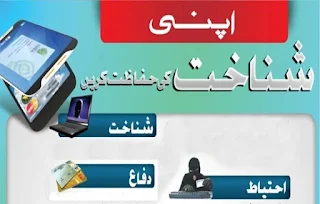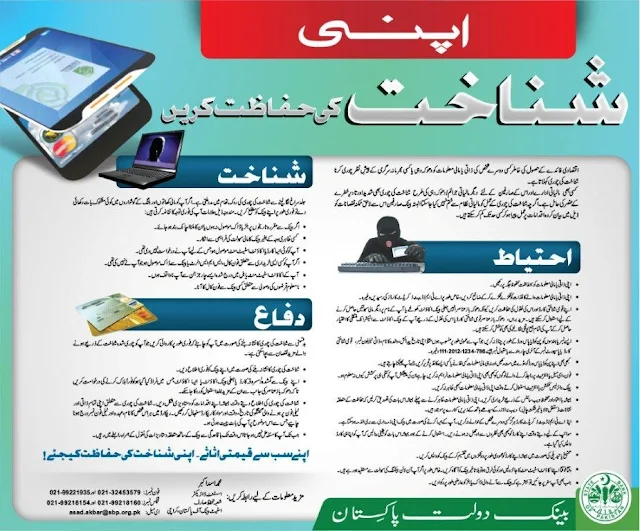Identity theft occurs when someone steals personal or financial information of another person to commit fraud or other criminal act for economic gain.
Like other financial crimes/ frauds, identity theft carries serious and pervasive threat for the financial institution and its customer alike. Although identity theft cannot be completely eradicated from the financial sector, however, adoption of following measures can minimize it by a larger extent. State Bank of Pakistan (SBP) has issued these guidelines/ instructions/ tips to protect you from identity theft.
Prevention from Identity Theft
- Keep your personal or financial information at a safe and secure place.
- Always shred papers with any personal or financial information, especially ATM/ debit/ credit card transaction receipts, when no longer needed.
- Protect your national identity card and its photocopies as these can be misused by fraudsters to open a fake bank account or obtain other financial facilities in your name. This may also authorize electronic transfers in your name from your accounts and drain your savings.
- Don't use such numbers as your PIN or password that can obviously be associated with you like your birth date, mother's maiden name, telephone number, last four digits of National Identity Card/ passport number or popular number sequences such as 786, 1234, 2012, 111 etc.
- Never carry PINs or passwords in your wallet or write any financial information on the outside of an envelope or on anything you are going to discard.
- Don't provide personal or financial information to people over phone, through email or on the internet, no matter how legitimate or enticing their offer may sound.
- Never disclose personal or financial information when using public wireless connection or internet facilities.
- Only shop at secure websites. Before entering any personal or financial information, always ensure that the security icon, the locked padlock or unbroken key symbol, is appearing in the bottom right of your web browser.
- Don't handover your ATM card or debit card or credit card to other persons. This action of yours may reduce the bank onus in case of fraud.
- Never let your card out of your sight for swiping purposes at any merchant establishment. After using your card, always make sure that the card returned is yours.
- Always cut your card into two vertical halves before returning it to your bank for limit enhancement or cancelation etc.
- Periodically check your bank statement and immediately contact your bank if you found any wrong entry. This is particularly important if you bank online.
- Always place your bills or mail on hold from banks while you travel to reduce the chances of theft.
- Important Instructions about ATM Cards from State Bank of Pakistan
- Precautions in Handling of Bank Cheques
- 15 Safety Tips for ATM Users
- 10 Tips for Parents to keep their Children Safe Online
Identify the Identity Theft
Early detection is always a key in preventing identity theft. Be alert in detecting and reporting any suspicious activity in your financial accounts and billing statements to your banker. The following signs may require your immediate attention:
- If mail or bills do not arrive on expected dates or suddenly stop arriving.
- Denial of financial facility by the bank for no apparent reason.
- Receive a card or account statement you didn't apply for.
- Receive calls, SMS alert about purchases you didn't make.
- Charges appearing in your bill or financial statement you don't recognize.
- Get collection call from any bank about unknown debits.
Defend Yourself from Identity Theft
Unfortunately, if you become a victim of identity theft, defend promptly. Your timely defense may prevent fraudsters from making further use of stolen identity to ruin your good name, your repute and peace of mind.
- Immediately report to the bank if you have become the victim of identity theft.
- Request the bank to block the lost/ stolen card or the bank account that has been fraudulently opened/ hit/ tampered to avoid further misuse.
- Always document your actions while reporting identity theft. Keep a log of the date, time and substance of all your personal visits and telephone conversations regarding the identity theft. The log should also include the name, title and telephone number of each person whom you have spoken on the subject.
- Regularly follow-up with your bank, with copies of supporting documents.


